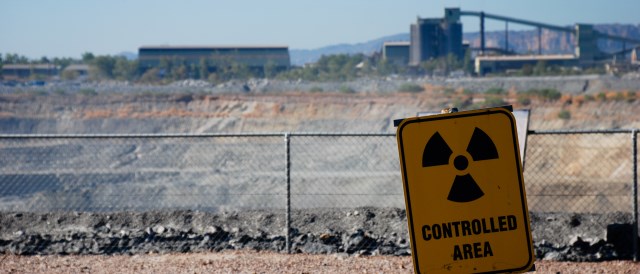Nuclear power is often considered “domestic” even when the uranium is imported. Craig Morris can’t help noticing how we are concerned about dependency upon oil and coal imports, but not uranium.

If this uranium mine does not look French to you, it is because France does not have any. (Photo by Bidgee, CC BY 2.0)
In a recent article, I talked about how watts per m2, an expression of energy density, is seldom used in Germany. The concept of energy density is commonly used to discredit renewables, with proponents of nuclear often comparing the amount of land needed to produce enough renewable power to replace a single nuclear plant (which takes up relatively little space). The conclusion is that we simply don’t have enough land to do without nuclear. One infographic artist created a chart showing the large number of wind turbines required to replace a single nuclear plant. US utility Entergy has also compared nuclear favorably to both wind and solar in terms of space (PDF).
Apparently, like wind turbines, these nuclear plants take fuel right out of the air. You see, none of these comparisons ever take account of the land used for uranium mining. And that has a rather bizarre outcome: nuclear power is considered domestic even when practically all of a country’s uranium is imported.
Take France, for instance, which gets more than 75 percent of its power from nuclear. Judging from this list made by the World Nuclear Association (WNA), France has practically made no uranium since 2004 – less than 10 tons per year, whereas the country actually consumes closer to 10,000 tons annually. In fact, France discontinued uranium mining in 2001 (PDF). And the list clearly shows that the biggest EU country in terms of uranium production, the Czech Republic, covers less than one percent of global demand.
The nearly complete lack of domestic uranium production within the EU has not, however, prevented nuclear from being considered domestic. Take a look at this chart from the European Commission from this year, which shows that the EU makes seven percent of the world’s energy, 28 percent of that from nuclear. Yet, almost all of the fuel for that power is imported. This assessment is nothing new judging from this EU factsheet for 2004 (PDF).
It gets worse – even the highbrow French geography series Dessous des cartes believes that French “energy dependence” is practically nonexistent thanks to nuclear – see this screenshot for yourself. Never mind that France imports almost all of its oil – and its uranium.
And then consider the irony: Germany faces criticism for its imports of hard coal. What’s more, the next time I fill up my car at a gas station in Germany, I’ll be sure to consider that “domestic oil.”
By the way, where does France get its uranium from? Mainly from Canada and Niger. Now I know what you’re thinking – didn’t the French recently send troops down to Niger, Mali’s neighbor, to protect their uranium mines? No, that’s just a conspiracy theory – don’t believe the meme, especially when it comes from such sources of ill-repute as the BBC, Reuters, and Deutsche Welle.
Craig Morris (@PPchef) is the lead author of German Energy Transition. He directs Petite Planète and writes every workday for Renewables International.
The above analysis does not even consider French fuel reprocessing (just 400 tons in a recent year, but it can be quickly ramped up if uranium prices increase). ATM, fuel reprocessing is more expensive than new mined uranium – but reprocessing dramatically lowers the volume and lifespan of the waste. The plutonium is put back into the reactor to be “burned”.
Fission byproducts (split uranium atoms) are not particularly toxic and after a 1,000 years most can be safely handled and even used. The platinum group metals and gold getting the most attention.
Reprocessing existing waste French fuel can supply several decades of reactor fuel for France. That is domestic fuel.
Reprocessing does not “dramatically lower…the volume and lifespan of the waste”; it partitions the waste into recovered plutonium, high-level waste whose volumetric concentration makes it awkward to store, and a variety of quite voluminous intermediate- and low-level waste streams and releases. The lifespan (as Alan Drake calls it) of the fission products that dominate in the high-level wastes is unchanged. Most but not all of the plutonium is separated, but a still-significant amount of long-lived transuranics stays in the diverse waste streams, which accordingly still have a long lifespan despite their dilution. In essence, reprocessing does not make nuclear wastes decay faster or go away, but does increase their entropy. That is why all careful independent studies of reprocessing have found that it complicates waste management, raises costs, raises proliferation risks, and has no business case.
People curious about the land area actually required for nuclear, solar, and windpower can find a peer-reviewed analysis at http://www.rmi.org/Knowledge
-Center/Library/2011-07_RenewableEnergysFootprintMyth.
France claiming domestic uranium from reprocessing is like Germany claiming domestic petrol because it can make it from coal. Neither is using domestic sources although they could. They are not using domestic sourced methods due to economics.